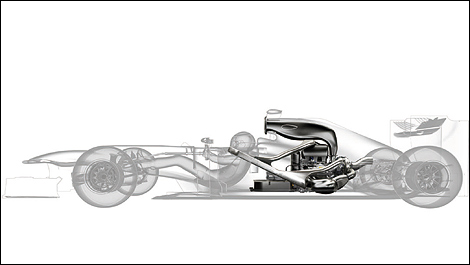Had someone claimed 10 years ago that in 2014, F1 cars would be powered by 1.6 l engines delivering over 600 bhp, he would most certainly have been laughed at. And yet that is precisely what has happened, one one hand testifying to the extraordinary technical progress F1 has gone through in the last decade, on the other to how difficult it is to predict the future. However it is not only the engines that will change in 2014. In fact the coming season will see the most fundamental changes to the sport since it all started, and for that reason we felt it could be useful to give you an overview of the most important areas affected, along with some thoughts on how that could influence the outcome of the 2014 championships – knowing, as mentioned, that predicting the future is difficult indeed…

They may have been less safe, but no doubt F1 cars looked better 10 years ago, in 2004…
Engine: all cars will be powered by a 1.6 litre, turbo-charged V6 engine, supported by an ERS system which replaces last year’s KERS and gives about twice the power of the latter. Max rev’s are limited to 15.000 rpm. The ERS system is highly complex and consists of two motors/generators, one linked to the engine, the other to the turbo. Not only will the power be higher, it will also be available for longer (in numbers 120 Kw during 33 seconds as opposed to the 60 Kw during 6.6 seconds given by KERS last year). The minimum weight of the whole unit is set at 145 kg. Max fuel for a race is set at 100 kg, a reduction of 40 kg versus last year.
Gearbox: made out of carbon, the ratios of the 8-speed gearbox may only be changed once during the season.
Chassis: no one has missed the more or less catastrophic look of the noses on the new cars. The reason for this design nightmare is new regulation, aimed at preventing cars from lifting off when hitting another car from behind. This is however only one of a number of chassis and body changes for 2014, mostly aimed at reducing traction and hereby lowering the cars’ cornering speed. The front wing may thus not be larger than 165 cm (-15 cm vs last year) and the whole lower part of the rear wing has been removed. The exhaust must now be mounted centrally in the back, the sideways mounted exhausts that helped aerodynamics are no longer allowed. The opening of the rear wing has been somewhat increased, helping the DRS effect. Finally the side boxes will look a bit different as the cooling system has increased in size, driven by the larger cooling need of the highly complex engine.
Weight: minimum weight has been increased by 49 kg to 691 kg, still however posing a big challenge to the teams as it only partly compensates for the increased weight of all the new components described above.

Fitting the engine with all its components into the new cars – not an easy task!
It is fair to say that the engineers have thus had a number of nuts to solve in order to fit everything into the new cars and try to meet (and optimize the outcome of) the new regulation. How well they succeed remains to be confirmed as the new season starts. Development costs money so it is probably fair to say that as always, the bigger teams, and especially the factory teams, have an advantage on paper. It is however easy to imagine that with all the complexity added, reliability will again be on the agenda, possibly along with fuel consumption. Clearly the new engines consume less, but we could well have more “excitement” towards the end of races when some drivers start to run out of fuel.
On a technical level, it seems therefore that the F1 circus will prove the Amis wrong: there is indeed a substitute for cubic inches. One question will however remain unanswered until March 16, when the season kicks off in Melbourne, and that is what 20 cars powered by 1.6 l turbo engines sound like, and whether acoustically you will still recognize this as F1 or rather think you are watching the Renault Clio cup. Let’s cross fingers and hope for the best…
Hoping all of these changes will also help change the results! Vettel was just annoying last season, winning everything. Wasn’t even worth watching. I’m hoping next season will be more exciting! Great blog mate, just followed you. Feel free to check out my blog and follow me back 🙂
Thanks for the compliments. As you say, fingers crossed for the new season! Happy to check out your blog.
Pingback: Jerez 2014 – French frustration, German satisfaction | The Thrill of Driving